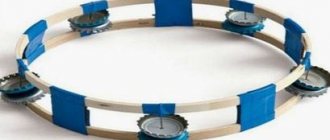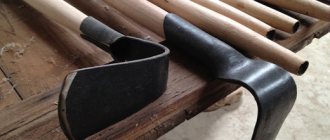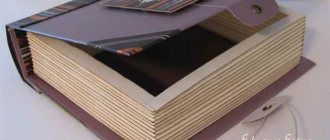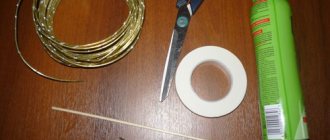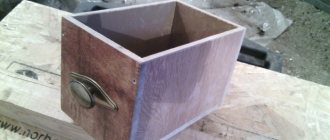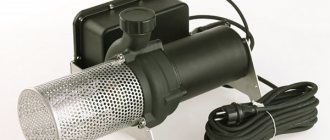How are drills, saws, woodworking tools, washers, nuts, clamps and a bunch of other necessary little things usually stored in a workshop or garage?
Most likely, most people store all this in cardboard boxes or in plastic paint buckets. Most often, small parts are stored in the form of a sort of assortment, and when you need to find a nut or some small key, you have to spend quite a lot of time searching. It even happens that new parts are purchased, since it is simply impossible to find the old ones in this pile. This situation is familiar to many. If you are one of them, then here you will find useful tips on how to easily and cheaply make special devices for storing tools.
Types of convenient boxes
According to the form of manufacture and purpose, tool boxes are classified:
- Portable.
- Stationary.
- Special.
Portable containers for carpentry tools are compact models, inside of which a small number of things needed for work can be placed. The complete set of the case depends on the specialist’s specialization. Its design involves a strong lock that will not open during long-term transportation. The portable box is constantly in motion, so it is important that there are several types of fastenings inside it, convenient niches in which you can, for example, put screwdrivers and secure them so that they do not dangle or knock.
It is quite difficult to make a stationary tool box with your own hands. And all because its design is much more complex than that of a portable one. There is no need to think through the arrangement of fasteners inside. The main thing is to form certain compartments and divide them into groups.
A special case is made for strictly individual needs
. It can, for example, only store drill bits or wrenches of various sizes. Such a box for small tools is more convenient than universal storage. To perform work, sometimes a master needs to take several special cases with him at once. Before you start making a storage unit, you need to decide which option is most suitable for the job.
To do this you need:
- make an inventory of available tools;
- arrange them into groups;
- distribute by size.
Then it will immediately become clear which box is best to make for tools. The article has several instructions that will help solve this problem. First, it is important to choose the material that will be easiest to work with.
Material selection
The hardest thing to make is a tool box made of metal. This material is not suitable for a portable design - the case will be too heavy. Suitable for stationary models in which iron keys or heavy components will be stored. Welding will be required during operation. If you have the skills and ability to use it, you can try it. If they are not there, plywood 8–10 mm thick can replace metal.
It only looks fragile, but it is a very durable material. The parts are fastened together with screws and additionally coated with PVA glue, as they will quickly become loose. To construct the frame, it is better to use hardwood blocks. The walls of the housing must be thicker - at least 10 mm. Boxes with compartments for carpentry tools are best made from 8 mm thick plywood.
The mobility of stationary plywood boxes will increase noticeably if you attach rollers to the bottom, which can be bought at a furniture store.
Boxes for various tools made of wood are carpentry classics. This material allows you to create any models with your own hands.
Small tool storage case
If you need to have a set of small tools on hand, you can get by with a simple box with a handle. The process of its manufacture must be divided into several stages:
- The first stage is planning, making general calculations, drawing. It should show the order of subsequent actions. The drawing is drawn up independently, or you can use computer programs.
- The second stage is the preparation of the necessary building materials. These are wooden sheets 10–15 mm thick, nails, and fasteners. For work you may need measuring instruments, a hacksaw and a hammer.
- The third stage is manufacturing. Using the instructions, you can assemble a simple open tool box with your own hands (photo).
Before starting work, you need to make a drawing.
- Number 1 – the walls of the box (two pieces).
- Number 2 – side panels (two pieces).
- Number 3 is the bottom of the box.
- Number 4 is a groove made according to the thickness of the partition. Its depth should be equal to one third of the thickness of the plywood.
All parts are cut out using a hacksaw using plywood blanks
. Then the edges of the workpieces are sanded with sandpaper. A box is assembled from the largest parts, its sides are coated with PVA glue, then additionally fastened with small nails (it makes no sense to use bolt fastening here). The handle-holder (which is also the partition) is made according to the following scheme:
Plywood with a thickness of 5 mm is selected. The hole for the handle is cut out using a jigsaw. The workpiece is inserted into the grooves made, which are pre-coated with PVA glue. To prevent the handle from cutting your hand, you need to take a block with a cross-section of 20x45 mm. The edges of the block are rounded with a plane. A slot is made across the entire width into which a piece of plywood is simply inserted. In the end it should look like this.
Along the edges of the plywood handle (this is clearly visible in the photo) wooden slats are attached, in which recesses-holders for pliers, pliers, wrenches or screwdrivers were previously made. The toolbox is ready. To prevent it from getting dirty, you need to paint it in several layers with wood varnish.
Using the same plywood, you can make a large box with your own hands, which with a slight movement turns into a stable stool. This was invented by craftsmen working with carpentry tools. You can take this drawing as a basis.
For these parts you need to make four legs measuring 375x50, with bevels at the ends made at an angle of 15 degrees. And also a handle 660 mm long and 40 mm wide. Along the edges there is the same bevel. And here is a visual plan of its assembly.
The stool is assembled according to the proposed scheme, the parts are fastened with 4.5x60 mm screws, and not with self-tapping screws. At the final stage you get a box like this. Making it yourself is simple, and the result is multifunctional storage for tools. If you turn it over, you get a stable stool.
Small portable option
There is the easiest option for making a box that is suitable for the average homeowner. Externally it will look like in the photo.
The model is accompanied by a detailed drawing:
Number 1 indicates the side, number 2 – the bottom of the wooden box, number 4 – the handle stand. The handle itself is a block measuring 382 by 30 mm. Another detail is the holder - a rectangle 118 mm wide and 55 mm long. You need to make three identical holes in the holder. A drill is used for this. Assembling a large box begins with connecting the bottom and side, then installing the handle stand. The photograph shows all stages of the upcoming work.
Then the second stand is installed, and at the same time the parka holder is inserted into the blind holes. Then the fasteners for screwdrivers are installed. This is what should happen in the end.
There are many professions that use different types of tools. Most often, tool boxes are purchased to store them, but sometimes it’s easier to make high-quality storage with your own hands
If you are interested in this or that type of craft, and you don’t sit at home with your hands folded, naturally, you collect a fairly large number of tools.
To ensure that your tools are always at hand and securely stored, they need to be provided with a safety system in the form of a separate closed space called a tool storage box.
In addition to safety, the use of such a box will greatly help in your work, since the contents will be neatly sorted into compartments and in the future you can find the necessary device “blindly”. This device is also needed by car owners, or rather by owners of trucks and gazelles. The box must be well secured in the car. This means that when making it with your own hands, you need to think carefully about where it will be located in the car and how to secure it there.
Decide on two criteria:
- Will you only store tools in it, or do you also need it for ease of transportation?
- What sizes of tools do you plan to store in it?
Classification of boxes
Based on body material:
- plastic – light in weight, convenient to use and for transportation;
- metal - much heavier than plastic, but at the same time much stronger, more stable, have a more rigid structure, cannot be large in size due to the heaviness of the metal;
- galvanized metal-plastic – lightweight, durable and spacious, suitable for both storing and transporting professional tools. But all these advantages also determine the corresponding price - it can range from $150 to $500 and above.
- wooden - the most affordable material for making a tool box. Moreover, it is easier to make with your own hands from this material, or rather from plywood 10 16 or 18 mm.
By type of stored instruments:
- hand tools - as a rule, they are represented by one large compartment for large tools (screwdrivers, hammers, keys) and 2-3 small ones for smaller tools;
- An electric tool is a case that is functionally designed to store and move a specific power tool. Most often it has one main compartment for the device itself and several recesses for equipment.
- organizers are boxes designed to accommodate a large number of tools of various sizes. They have many compartments; models with modular partitions, which can be rearranged from one place to another for the convenience of the owner, deserve attention.
- professional tools are a special type of case with specific mounting locations for specific tools that are more resistant to falls and adverse environmental conditions.
- non-professional tools - are boxes of both small and quite large sizes with many compartments and niches for various kinds of tools, often these are cases in the form of bags.
There are many companies that produce tool boxes, such as stanley, fit–
American companies,
keter
- an equally popular Israeli company, the Spanish company
Tayg,
the German
Kroft
and many others, differing in the quality and price of their products.
As an alternative to all these companies, there is the opportunity to make a tool box with your own hands. This way you can save on cost and get a very competitive option that meets your exact requirements.
Storage of scissors, wrenches, washers and nuts
To do this, you will need a perforated sheet of fiberboard attached to the wall of your garage or workshop, and thick wire. From the wire you need to make loops and hooks with detachable ends on which washers and nuts will be strung. For convenience, you can hang labels with the size of the fittings on each bundle. Keys and scissors can simply be hung on hooks.
Types of boxes
DIY tool boxes are mostly made from wood and come in a variety of shapes. Popular and easy to make boxes are the classic “basket” shape. in second and third place - a box in the shape of a chest - a container, and in the form of a case.
Storing screws and nails
You can also simply put a small magnet in your chest pocket and attach whatever you need on top of it. For the construction and construction of various structures, nails and screws, etc. are mainly used, and in this regard, you need to think about their storage. To store screws and nails, etc., we use different food containers with lids, since when we buy them in bulk (storage in bags) or in cardboard packaging (which, after opening, we had to throw away) this did not suit us because it is not convenient use for the safety of self-tapping screws, etc. If the length allows and the volume is not large, then boxes from monpensiers are used, if larger ones, then we use containers as in the photo below.
The advantages of using storage this way are ease of portability, relative compactness of storage (a square one would be more convenient), and budget-friendly. You can also use store-bought boxes, cardboard boxes, but they are not durable to use; you can make boxes from wood and plywood; this season we plan to make one for more compact storage. In order not to spend a long time looking for the right screw, etc., we use different containers for different lengths and try to write it on the container or use the manufacturer’s markings as in the photo below, the main thing is not to confuse the lid
zen.yandex.ru
Materials for making a tool box
- wooden boards 15-25 mm thick
- round wooden rod of the required length
- self-tapping screws, wood glue, sandpaper for cleaning surfaces
- set of tools – grinder, electric drill, jigsaw, screwdriver
- measuring instruments - ruler
- screwdriver, hammer
Manufacturing stages
Using this technology, it is possible to produce boxes of more complex designs, creating the required number of compartments and niches using partitions.
Using the same technology, it is possible to produce a closed box, which is more reliable and convenient for transporting tools.
Additional steps in making a box with a lid
For self-production of currently popular transforming boxes
You'll have to rack your brains more, but it's quite possible to implement this idea.
To do this, using computer programs, you need to develop the design you want, and a set of necessary elements that can be purchased in special stores will help you bring it into reality. The number and complexity of the selected elements depends on your requirements for the box. Assembly can be done on a wooden base using aluminum strips and angles. Fastening is done using rivets.
If you are a goal-oriented and creative person, then the process of making a tool box
will not be difficult, but when you see the fruits of this labor, you will increase your self-esteem and save budget funds.
Hello everybody!
Today, a tool box is a very indispensable thing for every owner. Most of us have a lot of different tools that we may not use very often, but nevertheless we keep them, since more than one repair cannot be done without them. To ensure that the tool is in one place and convenient to transport, we use special boxes. Often we simply buy them at the nearest store; the range and variety allows us to do this. But why not make it yourself? The manufacturing process is not too complicated, anyone should be able to do it, especially with something made by hand, which is much more pleasant to use than a purchased version. This article will describe 4 different methods of making boxes, a photo report is attached.
Let's start making!
Manufacturing method No. 1
We will need:
Material
Plywood; - pine board; - nails; - wood glue.
Tool
- drill; - hammer; - chisel; - manual frezer; - ruler; - pencil; - roulette.
The first step is to find the necessary material; plywood or scrap boards are suitable for this. Next, according to the presented drawing, you need to make markings, then cut out all the parts of the body. It is necessary to make special grooves in which the partition will be placed; for this we use a hand router or other available tool.
The diagram shows the following body parts:
1 — wall (2 pcs.); 2 — sidewall (2 pcs.); 3 - bottom; 4 - groove along the thickness of the partition and a depth of 1/2–1/3 of the thickness of the material
When everything is ready, all elements of the box body should be sanded. Next, we assemble the body together, fix the parts with wood glue, and then additionally fasten them with small nails.
Now we make a partition for the drawer, cut out a special handle, and use a jigsaw for this.
When the partition is ready, lubricate the grooves with wood glue and install it in its place. Next, we make overhead handles from the planks and round the corners using a planer. Then we make tool holders from the slats, use a jigsaw and a drill. The holes will serve as screwdrivers, and the square cutouts will accommodate pliers, etc. tool.
To ensure that the box does not get dirty and is protected from the environment, we coat the surface with varnish. As a result of the work done, we get this homemade box.
Manufacturing method No. 2
Box-stool
Material
Plywood or OSB; - wooden beam; - self-tapping screws; - wood glue. Tool
Available cutting tools; - screwdriver; - ruler; - pencil; - roulette.
We take an existing sheet of plywood, make markings on it, and according to the presented dimensions, cut out the cover (Fig. 1), then the longitudinal drawers (Fig. 2) and the sides (Fig. 3).
Next, we take a wooden beam with a cross-section of 40x50 mm, cut out a handle, and 4 legs with bevels at the ends at an angle of 15°. Next, we assemble the structure together, using self-tapping screws as fixing elements.
Parts layout:
1 - cover; 2 - drawer; 3 - handle; 4 - leg; 5 - sidewall.
When everything is ready, use sandpaper or a sanding machine to round off the sharp corners and clean the surface. Next, you can apply a protective coating.
The end result should be such an unusual tool box, which, if necessary, can be transformed into a regular stool, to do this, just turn it over and put it on its legs, with the help of it it will be convenient to reach the place we need, at a time when height does not allow do this.
Manufacturing method No. 3.
Box for a young master.
Does your child love to make things? We suggest making a small box with him where he will store his favorite instrument.
To make a box with your own hands we will need the following
Material
16 mm boards; - round wooden beam; - self-tapping screws; - wood glue.
Tool
Available cutting tools; - screwdriver; - ruler; - pencil; - roulette; - clamps.
First, we need to take existing boards with a cross-section of 16 mm, then we make markings according to the provided dimensions, after which we cut the wood into the component parts we need.
The drawing shows the following details:
1 - sidewall; 2 - bottom; 3 - handle; 4 — handle stand; 5 - holder.
Using sandpaper, sand the surface and remove sharp corners. When everything is ready, we begin to connect all the parts together, first we need to connect the bottom and sides, then we install the vertical posts along the marked lines and at the same time we install the horizontal handle.
We fix everything with glue and screws. Then we install special holders for screwdrivers.
Now you can paint, choose the color and coating at your discretion.
The toolbox is ready.
Manufacturing method No. 4
The next version of the tool box is well suited for carrying various equipment that we need; its appearance will be distinguished by its solidity and reliability.
To make a box with your own hands we will need the following
Material
The board is no thicker than 12 mm;
- self-tapping screws; - wood glue; - pen; — corners 8 pcs.; — latch 2 pcs.; — loop 2 pcs. Tool
Available cutting tool; - screwdriver; - ruler; - pencil; - roulette; - clamps.
To make the box we use wood such as pine, linden or poplar. The most optimal thickness of the boards will be 12 mm.
Next, we make markings according to the dimensions indicated in the drawings, after which we cut them into component parts, as shown in the photo.
The entire list of required parts.
In order to make sure that the wood was cut correctly, you need to put all the parts in a single box.
First, we assemble the bottom part and lid of the box; for convenience, we use clamps and corner clamps. We fix the parts together with wood glue.
Then, using a drill, we drill a hole for the screws and countersink the holes.
Any owner has many different tools and fasteners. Sometimes all this is stored in a separate box, on or in, neatly folded or piled in a heap. Often, when starting or when it is necessary to tighten the nuts, you have to search for a long time for the right wrench, screwdriver or pliers. A multifunctional tool box with compartments for wrenches, drills, fasteners, etc. will help avoid confusion. You can buy it in a store or make it yourself. In today's review by the editors of the site, we will look at the types of boxes for, what you can make from and how to assemble them with your own hands.
Tool boxes differ in the material used and the type of items stored. According to the material used they can be:
- wooden.
Wood is an affordable and easy to process material. To make the box, either durable multi-layer plywood with a thickness of 10, 16 or 18 mm is used. The complexity of the design depends on the wishes and skills of the master; - metal.
Steel or iron structures are quite heavy, but they are strong and durable. Lighter boxes are made of aluminum; - plastic.
These boxes are lightweight, durable, convenient and have a modern design.
The boxes also differ in the type of tool stored in them and are:
- Unprofessional.
They are a design with several compartments. They use bags or cases of different sizes. - Power tool.
Special boxes used for storing drills, etc. As a rule, such boxes are equipped with a large compartment for certain equipment and several small ones for additional equipment. - Professional.
Most craftsmen prefer this particular type of tool box, since they have separate seats for a certain type of equipment. - Universal.
Boxes of this type have a large number of compartments and are used to store a wide variety of items. There are tool boxes with removable partitions, which allows you to rearrange the internal space at your own discretion.
Garage ideas
In a garage, where space is already limited, zoning the space plays an important role in the arrangement. It is worth paying attention to the thoughtful division of the room into certain zones.
It may consist of the following parts:
- Area for storing large items.
- Corner for handicrafts and creativity.
- A place to work on the machine and other equipment.
An important point in creating a convenient and cozy garage is the correctly selected items and parts, containers and boxes in terms of color and size. After all, they not only give a neat look to the room, but are also able to create a comfortable atmosphere in the garage.
When tools are in an accessible place and neatly folded, work is more productive, faster and more enjoyable.
We invite you to consider interesting ideas and devices that can create order and profitably use every square meter in your garage:
- Hanging table . Can be stationary or folding. When folded, it occupies 10 cm from the wall, thereby not interfering with the passage and saving space in the workshop area. But if you raise the tabletop, you get a full-fledged workplace. The tabletop can be made of solid wood or high-strength polypropylene. It depends on how you will use the table.
- Engage the ceiling . You can make a suspended ceiling mezzanine, thereby freeing up a lot of usable space in the garage. For this, there are modular storage systems with a large number of accessories: mezzanines of different sizes, brackets of various types that can move on rails. This is an excellent solution for storing seasonal items.
- Hanging cabinets . Forget about cabinets standing on the floor - they can hang perfectly on the wall, and the shelves inside can be installed at any height. And if the cabinet is made of metal, then it can withstand heavy objects and be resistant to changes in temperature and humidity.
- Bracket for storing a bicycle . There are several different ways to store your bike. For example, if the height of the room allows, you can put it away under the ceiling for the winter. And in the summer, when it should be at hand, you can use a horizontal bracket. The bike can be easily removed so you can sit down and go for a ride.
- Hooks on the front of the cabinet . If you already have a large cabinet in your garage, you can hang hooks on the inside of the facade and place small parts of the appliances there. And on the outer part of the facade you can install a panel for larger tools. Thus making the closet more functional.
These space organization options will help you maintain order in your garage and easily find the thing or tool you need.
Walls can be made more functional by cleverly organizing additional storage spaces: by attaching brackets for mounting tires and bicycles, additional hooks or a hanging table
Design of tool boxes
Tool boxes are also divided by design. And here it is not the shape of the box that is meant, but the opening option and the presence of auxiliary compartments. The following designs are distinguished:
- case.
It is a rectangular box with a handle. They usually have several compartments and removable partitions, allowing you to plan the interior space as you wish. Such designs are small in size and weight; - container.
A fairly spacious box with partitions and separate containers that fold like a nesting doll. Sections can be folded up and to the sides, and the box itself is often equipped with wheels for easy transportation; - multibox.
This is a vertically positioned design in which the drawers and hardware are pulled out like in a traditional linen chest of drawers.
Storage of keys, cutters and drills
To store such products, you need to attach a foam or polyethylene foam pad to the wall, in which you need to make suitable holes for cutters, drills, etc. Thanks to the good elasticity of the material, all tools will be firmly fixed in their sockets and can be easily removed from them.
Requirements for tool boxes
When choosing a tool box in a store or deciding to make it yourself, you need to take into account some of the requirements for its design:
- The bottom of the box or container must be sufficiently thick and durable, since this is where the bulk of the contents fall.
- When the box is fully loaded and lifted, its walls should not be deformed.
- It is recommended to choose a structure made of fire-resistant material.
- There should be no gaps in the box so that dust and dirt do not get inside and contaminate what is stored in it.
For your information!
If you decide to purchase a tool box in a store, then give preference to multifunctional models with separate compartments and a closed inset organizer for small parts and fasteners.
Related article:
: what you should definitely have on hand. Read our publication for the main differences between similar tools, advice and recommendations from experts.
Storage of screws, self-tapping screws, nails and other small items
Plastic jars of horseradish, mayonnaise, etc. are perfect for storing such items. You just need to screw their lids to the horizontal surface of the shelf, and then screw the jars with the contents into these lids. You can also screw the lids to the vertical surfaces of the shelves, and cut half off the jars.
How to Make a Simple Open Tool Box
Inexpensive wood is most often used to make a tool box, especially if this is your first experience. We suggest making the simplest box without a lid. Its advantage is that it can fit and carry almost any size.
To make a simple tool box you will need a board, wood glue, self-tapping screws, or a drill and a hacksaw. The simplest box consists of:
- long walls (front and back) – 2 pcs.;
- narrow and high sidewalls (the height of the front and back walls should be greater, since the handle will be attached to them) - 2 pcs.;
- bottom (from a thick board) – 1 pc.;
- handles (square or round block, galvanized, chrome or aluminum tube) – 1 pc.
Assemble all parts into a single structure using wood glue and. Pay special attention to how the handle is secured. Such a box can be supplemented with internal partitions (removable or stationary), as well as a lid. Dimensions can be very different: it all depends on your needs and desires. Photos of the assembly are shown below.
Tool box made of plywood
First of all, you need to make a drawing and calculations and transfer them to plywood. Carefully mark, cut out parts along the intended contours and make grooves, thanks to which the structure will be more durable. All cuts must be sanded with sandpaper.
Next, the box is assembled. Glue is used to connect the parts. First, the frame is glued together (to make the work easier, you can use clamps or rubber rings). The handle is made from MDF and carefully processed or used from an old case or suitcase. To keep everything in its place in the box, you can make small compartments. One part of the box is reserved for a compartment for storing screwdrivers.
Related article:
: the best home gadgets that any self-respecting home owner should have on hand are in our publication.
Tips for keeping things organized
After completing the installation of shelving and panels, hanging all the tools and appliances, it’s time to think about maintaining this ideal order for a long time.
After all, after a week, a month or more, you still want to enjoy a systematic and neat environment. To adhere to this order and not confuse your devices, we recommend using hint marks .
After hanging it as compactly as possible, you need to stick stickers with the image of the device on their locations
The second way to organize the storage system is to designate it with numbers . It is necessary to mark the instrument itself and the place where it should hang with the same number.
To make it comfortable to work in the garage at any time of the year, you should take care of organizing ventilation and heating.
Wooden organizer with lid
This design is excellent for storing equipment, and is also durable, reliable and solid in appearance. To make it you will need:
- board;
- wood glue;
- metal corner pads – 8 pcs.;
- pen;
- self-tapping screws;
- furniture hinges – 2 pcs. or piano loop;
- latches-locks – 2 pcs.;
- drill;
- clamps;
- sandpaper.
Mark the parts on the boards according to the dimensions given below.
Detailing
| Name | Drawing number and quantity |
| Main drawer | |
| Front Panel | No. 1 – 1 pc. |
| Back panel | No. 2 – 1 pc. |
| Bottom | No. 3 – 1 pc. |
| Support rail | No. 5 – 2 pcs. |
| Side | No. 6 – 2 pcs. |
| Lid | |
| Top | No. 4 – 1 pc. |
| Front and back wall | No. 7 – 2 pcs. |
| Side | No. 8 – 2 pcs. |
| Removable tray | |
| Pen | No. 9 – 1 pc. |
| Bottom | No. 10 – 1 pc. |
| Long sides | No. 11 – 2 pcs. |
| Short sides | No. 12 – 2 pcs. |
| Partition | No. 13 – 2 pcs. |
Assembling the tool box
First of all, we assemble the box body and lid. To make it easier, use clamps and corner ties. The parts are connected using a special glue for carpentry. After the glue has dried, we drill holes, countersink them and carry out additional fixation with self-tapping screws.
Next, we assemble the removable tray in the same way, install partitions and additionally secure everything with self-tapping screws. Inside the box body, we install two strips on the short walls, spaced 300 mm from the top edge.
Once again we treat the tool box with fine abrasive paper to remove the slightest burrs. Cover the structure with a protective compound and allow to dry. If, after such treatment, raised wood fibers are found, then it is necessary to sand the box again and repeat the finishing.
To complete the assembly, you need to connect the cover to the body using hinges and self-tapping screws. Install the handle and latches-locks, as well as protective metal covers on all corners of the drawer. The box is ready, and now it can be filled with the necessary equipment and fasteners.
A few words in conclusion
A tool box is a must-have item for any craftsman. You can buy it at any hardware store or make it yourself according to your needs. We hope that the above examples of making tool boxes will be useful to you. If you have your own ideas, please share them in the comment form.
Every man will agree that a high-quality and multifunctional tool box is an almost irreplaceable thing in the household. Many craftsmen prefer to buy a ready-made box in the nearest store, where a wide range is available. But such a device can be made independently, in accordance with personal wishes. Moreover, the manufacturing process itself is not considered difficult, so even a beginner can cope with this task.
Making a box from plywood
To make a tool box with your own hands from plywood, you will need the following tools and materials:
Before you start manufacturing, you need to carefully work out the design of the future product (the drawing can be made on a computer or on plain paper). The necessary calculations are made and the main dimensions are recorded. After this, all marks need to be transferred to a sheet of plywood.
. This can be done using a regular ruler, tape measure, marker or even a pencil. All blanks for the future box are cut along the intended lines. It is also necessary to mark all the grooves and cut them on the blanks. Irregularities formed during the work process can be processed with a chisel. It is thanks to the grooves that the final design of the box will be stronger and more durable.
The next stage is the assembly of the entire structure. To glue small parts, use high-quality wood glue. The main sides of the box are also glued together. To improve the result, they need to be pressed tightly together. It is best to use a special rubber strip for this. It cannot be removed until the glue has completely dried. The corners on the doors need to be rounded.
A convenient handle for a tool box can be made from MDF. Initially, the layout is drawn directly on the wood and only then cut out. When the handle is ready, the surface must be processed. It is attached using wood glue and screws
. If you don’t want to make a handle yourself, then you can purchase it at a hardware store. The main criterion for the right choice is high strength and reliability. Now you need to attach the outer lid of the drawer and door. All parts are put in place, and then the areas for attaching the hinges are marked with a pencil.
To organize the drawer, you can make small compartments. All components are cut out according to the same principle as the box. Grooves are made and glued together. On one side of the box you can make a special compartment for storing screwdrivers. The most convenient option is where this function is performed by special inserts with slots made of plywood. Velcro is applied to the other side of the drawer to store cables and extension cords.
Instructions for creating a storage system
You can make an economical and convenient tool storage system yourself. This will take little time and effort and does not require much expense.
No. 1. Tool stand
You can purchase a ready-made tablet for storing tools, the base of which is made of a perforated metal panel. However, by building a stand with your own hands from leftover building material, you will not only save money, but also be able to make a structure that is suitable in size for your garage.
To make it you will need a piece of plywood, the remains of a welded mesh, and wire cutters.
Welded mesh and plywood are simple materials found in almost every garage. But in a matter of minutes they can easily turn into a very functional and convenient storage system
Stand manufacturing procedure:
- We attach the mesh to the surface of the plywood using self-tapping screws with a press washer. By biting the wire in the right place, you get a large number of hooks. They can be bent in any direction depending on what needs to be hung.
- Next, we distribute places for a compact arrangement of tools, make marks with a pencil to fix them.
- We hang clips for polypropylene on this design - we also get excellent holders for screwdrivers and pliers.
- For a screwdriver, a plastic adapter for a 50 to 70 pipeline is useful as a holder.
- If you have a piece of polystyrene foam or polystyrene foam, you can attach it to this stand to stick in all sorts of small things.
If there is still free space on the stand, you can install an interesting organizer for small items. It will require 110 gauge sewer plugs, some more clips and a piece of 25 gauge plastic pipe. It is better to place the holder near the side of the plug, then it will not rotate. You can attach the finished organizer to the stand using the same clips, but with latches.
No. 2. Organizer for small tools
To organize small parts, tools and gear that usually lie in different places in a chaotic manner, you can make a compact organizer.
For this you will need:
- plastic pipes of different diameters;
- a piece of any board;
- universal glue.
You need to make a 45 degree cut in the pipes. This method is very simple in that by making one cut, you get two blanks.
Next, all that remains is to glue them with the cut part to the board with reliable glue; for strength, you can fix them with screws at the base of the pipes.
After the entire structure is assembled, it can be hung on the wall, secured with self-tapping screws. All that remains is to place the necessary tools and other small things in the cells
In addition to the tool storage system for the garage, you can make many useful homemade products from plastic pipes for the home, garden, and vegetable garden.
No. 3. Wooden panel for storing small items
The simplest and most inexpensive device for storing all keys, screwdrivers and pliers are wooden panels. They save as much space as possible in the garage, and making them yourself is as easy as shelling pears. To make it, you can take the most ordinary board from leftovers after repairs.
Step-by-step instruction:
- You need to make markings on the board, then drill holes for the necessary fasteners. For convenience and effective planning, we advise you to arrange all the tools and devices on a prepared board in advance, and think about in what order and at what distance to attach them.
- We screw in all the screws according to the previously marked marks. To ensure that the self-tapping screw is firmly fixed when screwing in, it is recommended to pre-drill small holes of a smaller diameter, then it will be easier and more even to screw in.
- We attach the finished panel to the wall. Level it up. It is important to follow all safety rules when fastening. Do not forget to use personal protective equipment when working with electrical tools (glasses and dielectric gloves).
When attaching, be careful not to hit or touch any wiring inside the wall. It is advisable to know how it is laid. You can take the separation box as a starting point; it is always located under the ceiling, all the wires diverge from it.
Follow the basic rule: never drill vertically or horizontally from an outlet or switch..
After mounting the system on the wall, the most enjoyable part remains - placing all the tools and appliances in their places. If necessary, you can use various fastening elements for pipes and cables, a mounting bracket, fastenings of different thicknesses and sizes
If you plan to use a screwdriver or grinder when making a storage system, learn and follow safety precautions when working with power tools.
No. 4. Tool rack
The main structure, consisting of four vertical and several horizontal boards, connected to them crosswise.
It is important to note that the top edge of each horizontal board should be beveled at a 45-degree angle for hanging shelves and hanging containers. You can make such a cut using a circular saw.
Horizontal boards must be fixed at a certain distance from each other. This design will make it possible to insert the pendant into their holes.
The main advantage of such a rack is that all hanging elements are easily attached and removed. You can make shelves and storage devices yourself, or use ready-made boxes and attach a pendant to them.
During operation, you can add new structures, as well as move existing shelves in places.
Wooden box manufacturing technology
This option is considered a classic of carpentry. Drawings of this portable storage facility were published in magazines 50 years ago. For production you will need a high-quality board with a thickness of 10 to 20 mm
, as well as a hacksaw for wood. Thanks to the simple manufacturing technology, many craftsmen still choose this option.
The classic design does not provide for separate compartments or special multifunctional devices. The final product will look like a neat, deep box with a comfortable handle along its entire length. This shape of the handle has a practical purpose. After all, if the weight of the tools used is unevenly distributed, then you can always find the center of gravity point.
A practical addition could be an insert section with its own handle, the height of which occupies 50% of the entire drawer. This insert can be used for small tools
(awls, screwdrivers, small keys), as well as consumables (bits for screwdrivers, electrical tape, drills). Any type of wood can be used to make it.
Universal case made from a plastic canister
If you want to make a tool box with your own hands, but do not have a sheet of plywood, then you can use a regular plastic canister. To work you will need:
- Hacksaw.
- Plastic container.
- Fastening elements.
The canister used must be rectangular in shape with a comfortable handle, which should be located in the center. In addition, it should be equipped with a screw cap that will be used as a lock.
The process of making the box itself is quite simple. Using a hacksaw, you need to make cuts in the canister. The first cut should fall on the center of the neck and the handle of the container; it is best to remove the stopper
, and saw through the top wall. The second cut is made exclusively in the horizontal direction. It is best if it is located in the upper part of the canister, on the end sides. The plastic container itself must be cut from the top wall at a distance of 4 cm, and on the sides at a distance of 3 cm.
When all the cuts are made, the canister can be opened. To do this, you need to bend all the side parts of the top cover with the halves of the handle. In such a box you can store various materials for fastening: nails, bolts, screws, nuts. The upper part must be closed by folding the handles together. This device is secured with a screw cap.
To make the box as strong as possible, additional gaps must be made on the end walls
. Small holes are drilled in the lid itself or in the walls into which hooks are inserted, as well as bolts and nuts.

